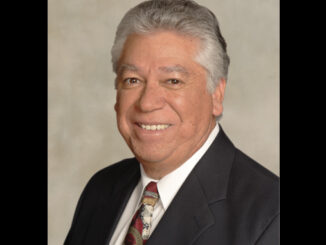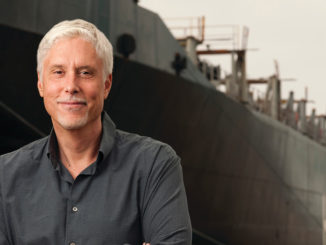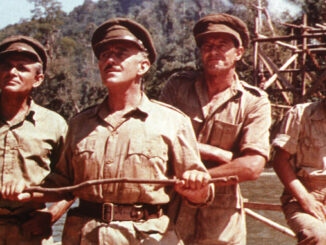
by Leslie Shatz
Go to Part 2.
Kay Rose’s career began in a film class at Hunter College in New York. When the professor realized that Kay knew more about film history than she did, she let her teach the class. In 1942,
Kay was hired by the Signal Corps as a film apprentice and worked on training films like the classic, How to Erect a Double Apron Barbed Wire Fence and documentaries like John Huston’s Report from the Aleutians. She started on a Tuesday morning and didn’t come home until Friday night. This was her introduction to movie-making.
She left the Signal Corps and came to Hollywood in 1944. In 1951, she married film editor Sherman Rose, and together they produced what is now considered a sci-fi cult classic, Target Earth. Sherman directed and edited and Kay cut the sound. They were the first to create an educational children’s television series in the 50s, with folksingers Marais and Miranda. They shared a soundstage with Orson Welles, who was shooting a little (never-released) film on his own, which Kay and Sherman then edited. When they divorced, Kay resumed full-time work.
Kay’s approach to sound editing has always been through story. “The story dictates what you do to it,” has been her mantra. It is her caring about the total filmmaking process that has attracted her to the directors she’s worked with: Sydney Pollack, Peter Bogdanovich, Robert Altman, Gene Kelly, Michael Ritchie, Martin Scorcese, Alan Pakula, Blake Edwards, Richard Brooks, Robert Redford, Barbra Streisand, Haskell Wexler, Robert Towne, Carl Reiner and Mark Rydell. It was her work on a Rydell film, The River, that earned her an Oscar for Best Achievement in Sound Editing, making her the first woman to be so honored. She served on the Board of Governors of the Aca demy from 1987-1993 and was chairperson of the Sound Effects Editing Award Committee. In addition to her Oscar, she has also won Best Sound Editing for The River from the Motion Picture Sound Editors. In 1994, she was honored with the MPSE’s Lifetime Achievement Award.
“I was never a dialogue editor only. I was either the supervisor or the only sound editor on a film. It depended either on the content of the film or its time schedule.” – Kay Rose
Her credits include: Intersection, The River, The Rose, Ordinary People, On Golden Pond, The Prince of Tides, For the Boys, The Way We Were, Tequila Sunrise, Milagro Beanfield War, Looking for Mr. Goodbar, Wrong is Right, The Professionals, The Cowboys, Paper Moon, California Split, Crimes of the Heart, Frances,All of Me, Where’s Poppa?, Nickelodeon, Daisy Miller, Bite the Bullet, New York, New York, The Candidate, Cinderella Liberty, Medium Cool, The Fox, and The Pit and the Pendulum.
We first met, I think, on Nashville. I don’t know if you remember –
Kay Rose: Well, I wasn’t on Nashville.
You didn’t work on Nashville?
KR: No, I didn’t. I worked on California Split, the first movie where dialogue was recorded on 8-track 1-inch tape. They were filming Nashville in Nashville while we were finishing California Split in Los Angeles.
I just remember this picture of you at the synchronizer with 8 dialogue tracks all lined up. I’d never seen such a thing – I remember thinking how incredibly innovative that was and still is.
KR: That was such fun, making something work that had not been done before and that nobody knew how to do. It was a challenge to work with Bob Altman and his crew.
When I worked there, I would see the door to the editing room open and a big cloud of marijuana smoke would blow out and at 5:00 pm they’d open a bottle of scotch. How did you deal with that?
KR: The picture editing crew worked upstairs – I worked downstairs. It was a good thing – I’m allergic to marijuana. After we ran the picture the first time Bob asked, “What’s this movie about?” I said it was about losers and he said, “That’s good – you do whatever you want to do – just make it work.” The only conversations we had after that were about crossword puzzles – honestly.
“The indiscriminate loudness of today’s sound tracks are hardest on mixers’ ears.” – Kay Rose
Whose idea was it to record 8-track dialogue on the set?
KR: When Bob Altman shot McCabe and Mrs. Miller he experimented using existing sound processes to get dramatic effects. For example, in the sequence where Warren Beatty and Julie Christie meet for the first time in a very noisy saloon, she propositions him to run a house of prostitution together.
She then proceeds to devour a huge breakfast. As Beatty watches her eating, the raucous background slowly fades away as he becomes entranced by her. His concentration wipes out everything else. In reality, when you focus intensely on someone or something, the background seems to disappear. This was difficult to accomplish on a mono-recorded scene with no ADR, but dramatically it was terrific. California Split was recorded on 8-track so that Bob could have separations – separations by place (different rooms) or area (background or foreground) or various combinations. For example, one sequence had seven mikes set up in various rooms so that the actors could walk around and talk and never go off mike. This was to be the prototype for Nashville . Jim Webb was the production mixer – he had recorded rock concerts like Joe Cocker and others so he was familiar with multi-track set-ups. Jack Cashin was the engineer and equipment designer. The Moviolas were set up to play fullcoat channels separately or together. Jim provided a complex sound report – every channel was described separately. He tried to keep each actor on his own track but since almost everything was ad libbed that didn’t always work.
As a dialogue editor you’re not usually presented with exotic things.
KR: Well, I was never a dialogue editor only. I was either the supervisor or the only sound editor on a film. It depended either on the content of the film or its time schedule. I was very fortunate because I started as a picture assistant and as such was on a picture from its beginning. On one small independent film early in my career, the producer/director decided that I could cut the sound, since assistants always replaced all the optical work tracks with new clean prints. But I had never done sound effects – I had no library – all I had was what they made while shooting. Some of my work on that film was a disaster. There was a ten-truck convoy starting and pulling out and I cut ten tracks with the same truck pulling out ten times! After we got to the third one, the mixers couldn’t contain themselves – they laughed and laughed.
“I have worked on some of the worst movies you’ve ever imagined but they were low budget independent films and I learned to do all kinds of things besides assisting.” – Kay Rose
So what do you think of the title of “sound designer?” Do you think it’s just a new name for something that –
KR: It took the early group of sound editors such a long time to get recognized by the Academy for their work. In the beginning, each studio’s sound department had a sound director who ran it and was the only one credited on its films. In 1939 a new category was established called the Special Effects Award, which was made up of Sound Effects bunched together with Visual Effects and called Photographic and Sound. The awards for these were given to the studio department heads. By 1957 the titles changed – now the awards were to be given to the Audible Effects Department supervisor and/or the Visual Effects Department supervisor. Each studio could enter its selections to be considered for one or both of the categories and each film excerpt was run for the nominating committee, which was made up of the Visual Effects department heads and the Audible Effects department heads. In 1961 I did a picture called The Pit and the Pendulum for American International Pictures. Linwood Dunn (visual effects) had seen the film at an Academy screening for Special Effects. He liked the sound job, so he nominated it. When the Academy sent its notification to AIP, the company said, “What department head?” because they had no sound or visual effects departments. But I was there working on another film so they sent me. And so it was – the special effects committee that year had all the top sound men in the business – and all the top visual effects supervisors – and me! I didn’t win but it was thrilling.
So did you consider what you were doing creative?
KR: Oh sure. I loved it whenever I could put unrelated sounds together and make something out of them. My sparse library was not adequate for the Pit and the Pendulum torture chamber so I went to Universal to see about renting their foley stage which, it turned out, was too expensive for AIP’s modest budget. Waldo Watson, Universal’s Sound Department head, said, “You don’t need foley – just use Universal’s library.” So I did – and made it all up as I went along. You see, working on those kinds of low budget, mostly independent pictures caused me to be more creative out of necessity.
Do you think the soundtracks are better now than they were?
KR: I liked yours. [The Mummy]
“People are working at home, which some think is good – but I like it when there’s a cohesion within the team.” – Kay Rose
I appreciate that. Your daughter [Victoria Sampson] told me you didn’t have to put in earplugs for it at the bake-off! [A special committee screening for Academy Award consideration in Sound Editing].
KR: It really is a problem – the indiscriminate loudness of today’s sound tracks are hardest on mixers’ ears. They’re being exposed to it on a daily basis. In the past they could count on the Academy roll-off curve – you could only raise the dub so far. When the level passed the curve it distorted on optical. It was eardrum protection for the mixers as well. [The Academy Curve was an equalization format used in conjunction with traditional, non-Dolby analog optical tracks to maximize speech clarity and minimize noise.]
Every director, as you must know, wants to raise the sound and as the day goes on, the dub gets louder and louder. I had only one director who would say “Let’s play back in the morning when my ears are fresh.” He was Mark Rydell, who directed The Rose, On Golden Pond, The River and For the Boys, among other films.
Did you find it difficult to advance in this field as a woman?
KR: No.
What about when you would go into a mixing theater and it was all men at the console and all men in the back room?
KR: I was taught by men. Like on my first effects job where I cut the ten trucks. One of the mixers, Bob Glass, Sr. had me come back every day at lunchtime for a couple of weeks and he and the dialogue mixer, Mac Dalgleish taught me how to lay out dubbing sheets for mixers – in essence, how to cut dialogue and sound effects.
How did you get started?
KR: I started as a film apprentice at the Signal Corps Photographic Center Editorial Department during WWII in Astoria, Long Island. The pay was very low, the hours very long, but most of the picture editors were from Hollywood. I was eager and I learned a lot. Then I came to California with letters
“As Beatty watches her eating, the raucous background slowly fades away as he becomes entranced by her. His concentration wipes out everything else. This was difficult to accomplish on a mono-recorded scene with no ADR, but dramatically it was terrific.” – Kay Rose
of introduction from the people I worked with in New York, to each studio’s editorial head. I waited for weeks for one of them to call me back, until my money ran out. I was down to my last five bucks – I was going to have to wire my mother for money so I could go back home. But I had never seen the Valley so I got on a streetcar and got off at Universal. I went up to the gate and asked the guard if I could call Editorial. He said. “What for?” and I said, ” I want to apply for a job.” He got hysterical with laughter and said, “That’s not how you get a job – but because you’re here, I’ll let you do it.” So I called Editorial and a man answered. He said “Are you any good?” Well, what do you say when someone asks you that? You say, “Yes.” And he said, “You’re hired!” A picture editor and his assistant had just had a falling out and the assistant quit and there were no experienced assistants available. When I was signing in, the assistant head of the department told me to go immediately to the Editors Guild, register and pay the initiation fee. I had been told by others that I could work on a permit for ninety days but he insisted I go right then. At the Guild office I was told to wire home for the initiation fee – $150. Where in New York at six o’clock at night are you going to get $150 with the banks closed and no credit cards in those days? My mother canvassed the neighborhood – we sat and waited. The money finally arrived. Four days later, the Society of Motion Picture Film Editors joined the IATSE and if you weren’t in by then you would have to wait years to get in. Talk about luck! I remained at Universal as a picture assistant for two years until the G.I.’s returned from the war.
We’re kind of spoiled today because a person can work as an apprentice on one job and they then feel ready to cut.
KR: I have worked on some of the worst movies you’ve ever imagined but they were low budget independent films and I learned to do all kinds of things besides assisting. One director even let me write added dialogue for his movie. Now the business has changed – it’s completely different. After the introduction of the computer, it became difficult for assistants to learn editing because they’re not standing behind the editor while he or she cuts.
“I loved it whenever I could put unrelated sounds together and make something out of them.” – Kay Rose
Everybody is in their own room with the door closed and there’s not as much interaction among a team. People are spread out all over the place.
KR: People are working at home, which some think is good – but I like it when there’s a cohesion within the team.
The transition to computers – did you make that transition? When you saw what was happening did you say this is not for me?
KR: No, I didn’t. I remember a demonstration of equipment held on a stage at Warner Hollywood. None of the people operating the computers knew anything about sound editing. They showed us the intricacies of the machines – what made them tick – instead of how they could be used to advance the art of motion picture sound.
You think that digital equipment is a change for the better?
KR: I can’t tell you that from personal experience but I’m sure it wasn’t for assistants. In 1986 I was doing a film in cutting rooms at CBS in Studio City. We were the only company working on film on the lot – everyone else was TV and computers. The editors and their assistants alternated weeks – the editor would work days one week and the assistant would work nights. The next week they would trade places – editor nights and assistant days. The assistants didn’t know what the editors were doing or why they were doing it.





